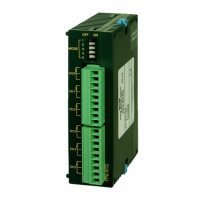FPΣ
High-speed Counter and Pulse Output Functions
6-20
6.4 Pulse Output Function
This section explains about the pulse output function of FPΣ.
6.4.1 Overview of Pulse Output Function
Instructions used and controls
The pulse output function enables positioning control by use in combination with a
commercially available pulse-string input type motor driver.
Providestrapezoidal(table-shaped)controlwiththe exclusive instruction F171 (SPDH)
for automatically obtaining pulse outputs by specifying the initial speed, maximum
speed, acceleration/deceleration time, and target value.
The exclusive instruction F171 (SPDH) also enables automatic home return operation.
A dedicated instruction, F172 (PLSH), is available for jogging operation, which causes
pulses to be output as long as the execution condition is on. A target value can also be
set, so that pulse output stops at the point when the target value is matched.
A dedicated instruction, F174 (PL0H), is available that outputs pulses in conformance
with the data table, so that positioning control can be carried out in accordance with the
data table.
A dedicated instruction, F175 (SPSH), is available for linear interpolation control. This
enables pulses to be output using linear interpolation control, by specifying the
composite speed, the acceleration/deceleration time, and the target value.
A dedicated instruction, F176 (SPCH), is available for circular interpolation control. The
user can select one of two circular forming methods, one by specifying the pass
positions and the other by specifying a center position. Pulses are output using circular
interpolation control, by specifying the various parameters.
Note
The linear interpolation control instruction F175(SPSH) and
circular interpolation control instruction F176(SPCH) can be used
with the C32T2 control unit only.
Setting the system register
When using the pulse output function, set the channels corresponding to system
registers 400 and 401 to “Do not use high-speed counter.”

